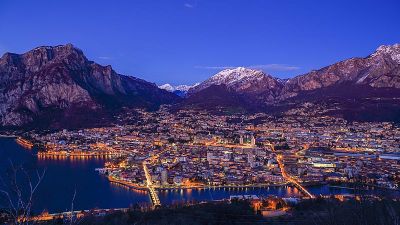L'articolo spiega la vita di Antonio Stoppani che scrisse nel 1876 "Il Bel Paese: conversazioni sulle bellezze naturali, geologia e geografia fisica dell'Italia". Fu prete a Monza ma dopo pochi anni divenne professore di geologia al Politecnico di Milano. Durante questo periodo, ha svolto ricerche sull'epoca antropozoica, quando, secondo lui, era "la prima traccia dell'uomo". All'inizio, gli scienziati di questo tempo non erano favorevoli alle sue teorie. Attualmente, invece, stanno osservando il suo lavoro con rinnovato interesse sia il suo libro che la sua ricerca rendendo Stoppani ad oggi molto conosciuto. Nel 1785 invece nacque Alessandro Manzoni anch’egli legato al lago di como e Lecco nei suoi scritti tant’è che Manzoni fu lo scrittore del libro "I promessi sposi". La storia racconta di amore e difficoltà durante il dominio spagnolo. Quando scrisse, l'Italia era in un estremo tumulto politico oltre che sociale. Manzoni scrisse in dialetto toscano, che divenne la lingua ufficiale del paese. “I promessi sposi” si legge ancora in un centinaio di lingue e nelle scuole italiane.
Italy – well known for the beauty of its land, architecture, and art; its splendor in design, fashion and cars; its delectable food and wine; and its influence on music, dance, film and literature – is often referred to as il bel paese, the beautiful country.
The phrase, although sometimes associated with the works of Dante and Petrarch, is from “Il Bel Paese: conversazioni sulle bellezze naturali, la geologia e la geografia fisica d’Italia” (“The Beautiful Country: conversations on natural beauty, geology and physical geography of Italy”), written in 1876 by Antonio Stoppani. Stoppani studied and wrote about the people and culture of Italy and how it relates to the natural beauty of the land. He states: “Italy is almost – I don’t stammer in saying this – the synthesis of the physical world.” The book became a best seller, with over 100 editions sold, and used in classrooms throughout Italy.
Stoppani was born in Lecco (on the southeastern shore of Lake Como, region of Lombardy) in 1824. He had at least eight siblings and is related to Renilde Stoppani, the mother of Maria Montessori. Nestled between the lake and the Alps, the natural surroundings inspired Stoppani at a young age; and his early studies in religion led him to a seminary in Monza. In 1848, at 24, he was ordained a priest, and that same year participated in Milan’s resistance of Austrian rule in the Five Days of Milan. His political ideology caused a split with the church, and he renewed his interest in nature, studying and writing several books about geology and paleontology, from his theological point of view.
After Italy was united, Stoppani became a professor of geology at Politecnico di Milano. Acknowledged for his original findings on Italian geology and paleontology, in 1873, his three-volume “Corso di geologia” was published. In it, he writes about a new geological time scale, the “Anthropozoic era,” that started with “the first trace of man.” At the time, scientists didn’t pay attention to his theory, but as studies show the effects of human activities on earth, Anthropocene is being used to describe the era; and there is a renewed interest in Stoppani’s work.
Although born in Milan (about 30 miles southwest of Lecco) in 1785, Alessandro Manzoni immortalized Lecco in his classic tale, “I Promessi Sposi” (“The Betrothed”). First published in the late 1820s, the novel is considered Manzoni’s great masterpiece: an account of love and hardship in the late 1620s under Spanish rule, during war and a resurging plague. Manzoni’s father owned land near Lecco, and Manzoni’s descriptive passages reflect his remembrances of the town. An excerpt from the first page: “That branch of the lake of Como, which extends towards the south, is enclosed by two unbroken chains of mountains, which, as they advance and recede, diversify its shores with numerous bays and inlets. Suddenly the lake contracts itself, and takes the course and form of a river, between a promontory on the right, and a wide-open shore on the opposite side. The bridge which there joins the two banks seems to render this transformation more sensible to the eye, and marks the point where the lake ends, and the Adda [River] again begins … Lecco, the principal of these towns, giving its name to the territory, is at a short distance from the bridge, and so close upon the shore, that, when the waters are high, it seems to stand in the lake itself.”
When Manzoni wrote his epic, the Italian peninsula was deep in political and social turmoil. As rebellions against foreign rule became more frequent, plans for a unified Italy were strengthening; and although an Italian republic was several decades in the future, Manzoni rewrote his novel in the Tuscan dialect, the vernacular that would become the language of a united Italy. Published in 1840, the revised version has been released in hundreds of editions worldwide – most recently in a new translation for English readers – and continues to be an essential read in Italian classrooms.
“Il Bel Paese” and “I Promessi Sposi” are considered two of Italy’s most acclaimed publications, and both have their roots in Lecco.



